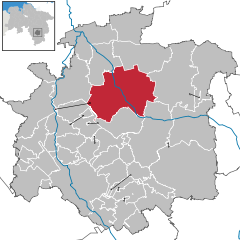Hildesheim
| Hildesheim | |
 |
|
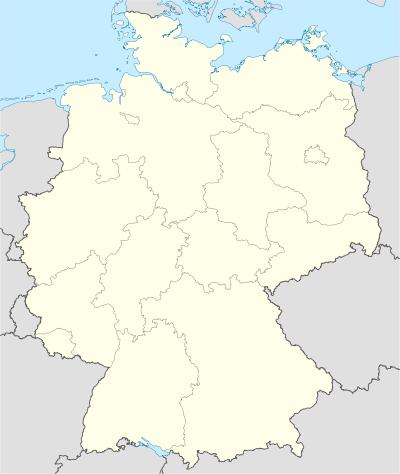 |
|
|
Location of within Hildesheim district
|
|
|---|---|
| Coordinates | |
| Administration | |
| Country | Germany |
| State | Lower Saxony |
| District | Hildesheim |
| Mayor | Kurt Machens |
| Basic statistics | |
| Area | 92.96 km2 (35.89 sq mi) |
| Elevation | 78 m (256 ft) |
| Population | 102,903 (31 December 2009)[1] |
| - Density | 1,107 /km2 (2,867 /sq mi) |
| Other information | |
| Time zone | CET/CEST (UTC+1/+2) |
| Licence plate | HI |
| Postal codes | 31101–31141 |
| Area code | 05121 |
| Website | www.hildesheim.de |
Hildesheim is a city in Lower Saxony, Germany. It is located in the district of Hildesheim, about 30 km southeast of Hannover on the banks of the Innerste river, which is a small tributary of the Leine river. It may be reached from Autobahn A7, which links Kassel, Göttingen and Hannover, and routes 1, 6, 243 and 494.
Contents |
History

Hildesheim, one of the oldest cities in the North of Germany, became the seat of the Bishopric of Hildesheim in 815 and may have been founded when the bishop moved from Elze to the Innerste ford, where it was an important market on the Hellweg trade route. The settlement the cathedral very quickly developed into a town which was awarded market rights by King Otto III in 983.[2] Originally the market was held in a street called Old Market (Alter Markt) which still exists today. The first market place was laid out around Saint Andrew's Church. When the city grew further, a bigger market place became necessary. The present market place of Hildesheim was laid out at the beginning of the 13th century when the city had about 5,000 inhabitants. When Hildesheim obtained city rights in 1249, it was one of the biggest cities in Northern Germany.[3] For four centuries the clergy ruled Hildesheim, before a city hall was built and the citizens gained some influence and independence. Construction of the present City Hall started in 1268.[4]In 1367 Hildesheim became a member of the Hanseatic League. A war between the citizens and their bishop cost dearly in 1519-1523 when they engaged in a feud. Hildesheim became protestant in 1542, and only the cathedral and a few other buildings remained in imperial (catholic) hands. Several villages around the city remained catholic as well. In 1813, after the Napoleonic Wars, the town became part of the Kingdom of Hanover, which was annexed by the Kingdom of Prussia after the Austro-Prussian War in 1866 as a province.
The city was heavily damaged by air raids in 1945, especially on March 22. Although it had little military significance, two months before the end of the war in Europe the historic city was bombed as part of the Area Bombing Directive in order to undermine the morale of the German people. 28.5% of the houses were completely destroyed and 44.7% damaged. 26.8% of the houses remained undamaged. The centre, which had retained its medieval character until then, was almost levelled. As in many cities, priority was given to rapid building of badly needed housing, and concrete structures took the place of the destroyed buildings. Fortunately, most of the major churches, two of them now UNESCO World Heritage Sites, were rebuilt in the original style soon after the war. During the war, valuable world heritage materials had been hidden in the basement of the city wall. In 1978, the University of Hildesheim was founded. In the 1980s a reconstruction of the historic centre began. Some of the unattractive concrete buildings around the marketplace were torn down and replaced by replicas of the original buildings. In the fall of 2007, a decision was made to reconstruct the Umgestülpter Zuckerhut ("Upended Sugarloaf"), an iconic half-timbered house famous for its unusual shape.
Religions
In 1542, most of the inhabitants became Protestants. Today 28.5% of the inhabitants are Roman Catholics and 38.3% are Protestants. 33.0% of the inhabitants are adherents of other religions or do not have a religion at all.
Main sights






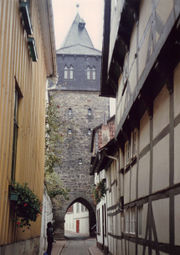
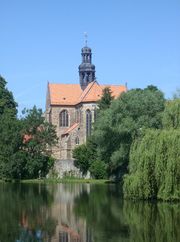




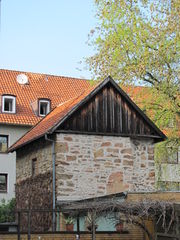


- The historic market place (Markt) was once considered one of the most beautiful market places in the world. It was reconstructed in 1984–1990 in its former splendour, after its destruction in the March 1945 air raid. The more noteworthy buildings in the square are:
- The Knochenhauer-Amtshaus ("Butchers' Guild Hall"), known as a beautiful and fine specimen of half-timbered building. Originally built in 1529 and destroyed in 1945, it was reconstructed from 1987 to 1989 according to original plans. The façade is sumptuously decorated with colorful paintings and German proverbs. Today the building houses a restaurant and the City Museum.
- The Bäckeramtshaus (Bakers' Guild Hall) is a half-timbered house which was originally built in 1825. It was destroyed in 1945 and rebuilt 1987-89. Today, it houses a café.
- The Town Hall, erected in the 13th century in Gothic style. Partly destroyed in 1945, it was rebuilt and inaugurated in 1954.
- The Tempelhaus, a late-Gothic 14th century patrician house, which today houses the tourist information office. It suffered some damage during the Second World War but was restored and inaugurated in 1950.
- The Wedekindhaus, a 16th century patrician house, is characterized by its high, ornately carved storeys including their ledges with depictions of allegorical figures.
- The adjoining Lüntzelhaus was built in 1755 in baroque style.
- The Rolandhaus was originally built in the 14th century in Gothic style. In 1730, the house was remodelled, and an impressive baroque portal and a large bay window were added.
- The Stadtschänke (Old City Tavern) is a large half-timbered house which was originally built in 1666. The smaller adjoining Rococcohaus was built in 1730 in rococco style.
- The Wollenwebergildehaus (Weavers' Guild Hall) was approximately built in 1600.
- The Romanesque St. Mary's Catholic cathedral, with its ancient bronze doors (Bernward's door) (c. 1015). The church was built in the 9th century, but almost completely destroyed in 1945; it was reconstructed soon after the war. It is listed as an UNESCO World Heritage Site since 1985. The "Thousand-Year-Old Rosebush" is a reputedly 1,000 years old dog rose bush, allegedly the world's oldest living rose. It continues to flourish on the wall of the Cathedral apse.
- Museum of the Cathedral: Cathedral Treasure.
- St. Michael's Church (UNESCO World Heritage Site) – a noteworthy early Romanesque church in Germany and a unique example of Ottonian architecture. It was built from 1010 to 1022.
- The Andreaskirche (St. Andrew's Evangelical church), a 12th century church with the highest church steeple (120 m) in Lower Saxony. From the top you get an interesting view of Hildesheim and its surroundings.
- The Roemer-und-Pelizaeus-Museum, with significant collections from the ancient Egypt and Peru and spectacular special exhibitions organized every year.
- The Kreuzkirche (Church of the Holy Cross) was originally a part of the medieval fortifications. It was converted into a church around 1079, severely damaged in 1945 and rebuilt after the war.
- The Godehardikirche (St. Godehard's Church), built 1133–1172, a Romanesque basilica minor, which is scheduled to become an UNESCO World Heritage Site in the near future.
- The Kehrwiederturm (Kehrwieder Tower), built around 1300, is the only remaining tower of the medieval fortifications.
- Half-timbered houses which were not destroyed during World War II can be seen around St. Godehard's Church and the Kehrwieder Tower, in the streets Kesslerstrasse, Knollenstrasse, Am Kehrwieder, Gelber Stern, Lappenberg, Bruehl, Hinterer Bruehl, and Godehardsplatz. Some of them have beautiful wood carvings in their façades, e.g. the Wernersches Haus (1606) in Godehardsplatz and the Waffenschmiedehaus (weapon smith house, 1548) at Gelber Stern.
- The Monument of the Synagogue (consecrated in 1849 and destroyed by the Nazis in 1938) was erected in 1988 in the old Jewish quarter on Lappenberg Street, one of the most beautiful streets in Hildesheim. The foundations were reconstructed and give you an idea of how big the synagogue was. The reddish brick building (built around 1840) opposite was the Jewish school.
- Mauritiuskirche (St. Maurice's Church), a romanic church (11th century) on a hill in the west of the city in the district of Moritzberg with a beautiful cloister. The interior of the church is baroque and the tower was added in 1765. From the forest behind the church you get a beautiful view of Hildesheim with many different churches.
- Kaiserhaus (Emperor's House): Renaissance building (1586) in Alter Markt, the oldest street of Hildesheim, rebuilt after the war. The façade is decorated with Roman statues and medallions. Opposite, there is a noteworthy sandstone bay window dating from 1568. Originally, it belonged to a private house which was torn down at the end of the 19th century. The bay window was dismantled before and added to another house in the Estern part of Hildesheim which remained undamaged during World Wart II. From there, the bay window was removed when the house was remodelled and added to the school at the present site in 1972.[5]
- Close to the Kaiserhaus (Emperor's house) the Alte Kemenate, a noteworthy medieval store house reaching a height of 5.5 meters, can be seen behind the school in the street Alter Markt. It has a rectangular basis measuring 6,5 meters x 5,0 meters and a cellar with a vaulted construction.[6] The store house, one of the oldest profane buildings in Hildesheim, was built of sandstone in a gothic style the 15th century. According to other sources it might be even older, i.e. built between the end of the 11th and the middle of the 13th century.[7] The building has two floors. As it did not consist of wood it did not burn down in 1945, but was only damaged and immediately repaired after the war. From 1945 - 1951 it was used for residential purposes. The Alte Kemenate is not open to the public, but you get a good impression from the school yard or from the small side stret Schenkenstrasse.
- St. Magdalena's Church (Magdalenenkirche) is a small church with large lancet windows in the historic street Old Market (Alter Markt) which was consecrated in 1224. It was originally built in a romanesque style, but enlarged and remodelled in a gothic style in 1456. It houses a wooden altar (about 1520) with carvings and other works of art. In the small street Suesternstrasse, a well-preserved part of the medieval city wall with a round tower is worth a visit behind the church. Opposite the church, a tall half-timbered house which was rebuilt in 1981 on the medieval city wall can be seen in the small side street Mühlenstraße. The façade is decorated with wood carvings.
- The baroque park Magdalena's Garden (Magdalenengarten), which was laid out in 1720 - 1725, is near St. Magdalena's Church. There are many different kinds of rose bushes, a rose museum, pavilions, baroque statues, a well-preserved part of the medieval city wall in it and even a vineyard yielding 100 - 200 bottles of wine per year. In spring, a rare species of wild yellow tulips (tulipa sylvestris) blossoms in the western part of the park.
- Steuerwald Castle (Burg Steuerwald) in the north of the city, about 3 km from the Market Place, was built 1310–1313. Its tower (25 m) was added in 1325. The chapel, dedicated to St Magdalena, was originally built in the Romanic style and transformed into a Gothic chapel in 1507. Today it is used for weddings and concerts.
- Marienburg Castle (Burg Marienburg) is in the southeast of Hildesheim, about 6 km from the Market Place. It was built 1346-1349.
- Sorsum is a former village in the West of Hildesheim which became a part of the city in 1974. There is a sightworthy former domain, founded in the Middle Ages, which was transformed into a residential area after 2000. The pigeon tower, built in 1733, the large barn (1786) and the impressive manor house dating from 1734 are interessting sights in this rural part of Hildesheim.
- Marienrode Priory (Kloster Marienrode) is in the southwest of Hildesheim, about 6 km from the Market Place. It was founded in 1125. The foundation stone of the present church was laid in 1412. The church was built in gothic style with three naves and completed in 1462. The baroque ridge turret was added in the 18th century. In the church, there are two noteworthy baroque altars dating from 1750 approximately and a gothic sandstone sculpture of Saint Mary which was made in 1460. The organ dates from the middle of the 18th century. A small chapel of the priory, Saint Cosmas and Damian, which was built in 1792, was converted into a small Protestant church in 1830. The priory was dissolved in 1806, but returned to the Catholic Church in 1986. Since 1988, it has again been operated by nuns. Near the monastery there is a large fishpond with a scenic view and a tall windmill built in 1839. The area is specially beautiful at cherry blossom time.
Other places of interest include the Theatre, offering opera, operetta and musicals, drama, ballet and concerts.
Districts
- 001 Mitte (central)
- 002 Neustadt
- 003 Nord (north) with Steuerwald
- 004 Süd (south)
- 005 Ost (east)
- 006 Galgenberg and Marienburger Höhe
- 007 Drispenstedt [districts 1]
- 008 West (west)
- 009 Moritzberg
- 010 Neuhof with Hildesheimer Wald [districts 2]
- 011 Ochtersum [districts 1]
- 012 Marienrode [districts 2]
- 013 Sorsum [districts 1]
- 014 Himmelsthür [districts 1]
- 015 Bavenstedt [districts 1]
- 016 Einum [districts 1]
- 017 Achtum-Uppen [districts 1]
- 018 Itzum [districts 1]
- 019 Marienburg
Incorporations
- 1911: Moritzberg
- 1912: Steuerwald
- 1938: Drispenstedt and Neuhof
- 1971: Ochtersum
- 1974: Achtum-Uppen, Bavenstedt, Einum, Himmelsthür, Itzum, Marienburg, Marienrode and Sorsum
Population history
| Year | Population |
|---|---|
| 1400 | ca. 6,000 |
| 1450 | ca. 8,000 |
| 1648 | ca. 5,500 |
| 1803 | 11,108 |
| 1825 | 12,630 |
| 1849 | 14,651 |
| 1871 | 20,801 |
| December 1, 1875 ¹ | 22,581 |
| December 1, 1890 ¹ | 33,481 |
| December 1, 1900 ¹ | 42,973 |
| December 1, 1910 ¹ | 50,239 |
| October 8, 1919 ¹ | 53,499 |
| June 16, 1925 ¹ | 58,522 |
| June 16, 1933 ¹ | 62,519 |
| May 17, 1939 ¹ | 72,101 |
| September 13, 1950 ¹ | 65,531 |
| June 6, 1961 ¹ | 96,296 |
| December 31, 1970 | 93,400 |
| June 30, 1975 | 106,000 |
| June 30, 1980 | 102,700 |
| June 30, 1985 | 100,900 |
| January 1, 1989 | 103,512 |
| June 30, 1997 | 105,700 |
| December 31, 2002 | 103,448 |
¹ census data
List of mayors of Hildesheim
- 1803–1843: Georg Otto Ferdinand Lohde
- 1843–1848: Carl Christoph Lüntzel
- 1848: Commissioned by Oberg, Starke and Wynecken
- 1848–1852: Amtsassessor Domeier
- 1853–1875: Paul Johann Friedrich Boysen
- 1876–1895: Gustav Struckmann
- 1895–1896: Hans Ukert, not as mayor
- 1896–1909: Gustav Struckmann, reelected
- 1909–1937: Ernst Ehrlicher
- 1945–1946: Erich Bruschke
- 1946–1950: Albin Hunger
- 1950–1952: Friedrich Lekve
- 1952–1958: Albin Hunger, reelected
- 1958–1959: Paul Lienke
- 1959–1964: Martin Boyken
- 1964–1968: Friedrich Nämsch
- 1968–1972: Martin Boyken, reelected
- 1972–1975: Friedrich Nämsch, reelected
- 1975–1981: Heiko Klinge
- 1981–1991: Gerold Klemke
- 1991–2001: Kurt Machens
- 2001–2005: Dr. Ulrich Kumme
- 2005–present: Kurt Machens, reelected
Twinnings

 Angoulême, France, since 1965
Angoulême, France, since 1965 Al Minya, Egypt, since 1975
Al Minya, Egypt, since 1975 Weston-super-Mare, United Kingdom, since 1983
Weston-super-Mare, United Kingdom, since 1983 Padang, Indonesia, co-op city since 1988
Padang, Indonesia, co-op city since 1988 Halle, Germany, friend partnership since 1990
Halle, Germany, friend partnership since 1990 Gelendzhik, Russia, since 1992
Gelendzhik, Russia, since 1992 North Somerset, United Kingdom (unitary authority based in Weston-super-Mare), since 1997
North Somerset, United Kingdom (unitary authority based in Weston-super-Mare), since 1997 Pavia, Italy, since 2000
Pavia, Italy, since 2000
Events of international interest
- M'era Luna Festival, Europe's most important event of the gothic and wave scene
- Jazz festival every May or June
Economy
Hildesheim is home to notable multinational corporations – besides many strong medium-sized companies – in Hildesheim are Blaupunkt, Bosch, Krupp, Thyssen, Fairchild and Coca-Cola.
Transportation
Hildesheim has an efficient traffic infrastructure: it is a regional hub for interstate roads and railroad (InterCityExpress), is connected to the motorway (Autobahn), has a harbor at the artificial waterway Mittellandkanal and an airport.
Notable residents
- St. Bernward, bishop of Hildesheim
- Nadine Chanz, Playboy Playmate
- Saint Godehard, also known as St. Gotthard, bishop of Hildesheim
- Jakob Guttmann (1845–1919), chief rabbi, philosopher, pedagogue
- Julius Guttmann (1880–1950), German and Palestinian rabbi, Jewish philosopher and historian
- Frederick Hornemann, African explorer
- Adolf Hurwitz, notable 19th century German mathematician
- Sir Hans Adolf Krebs, Nobel Prize in Physiology and Medicine in 1953
- Diane Kruger, supermodel and actress, who played in Troy
- Didrik Pining, a 15th century explorer of the North Atlantic, was born in Hildesheim
- Thomas Quasthoff, bass-baritone singer
- Henry Rathbone, U.S. Consul, imprisoned in Hildesheim.
- Rudolf Schenker, founder and guitarist of Scorpions
- Oskar Schindler (1907–1974) died in Hildesheim
- Maik Taylor, Northern Ireland and Birmingham City footballer
- The twins Wolfgang and Christoph Lauenstein, winners of an Academy Award in 1989 for their movie Balance
Gallery
 |
 |
 |
 |
 |
 St. Mauritius Church. |
 Half-timbered houses in Kesslerstrasse. |
Half-timbered houses in Hinterer Brühl Street. |
See also
- Metropolitan region Hannover-Braunschweig-Göttingen-Wolfsburg
References
- ↑ "Bevölkerungsfortschreibung" (in German). Landesbetrieb für Statistik und Kommunikationstechnologie Niedersachsen. 31 December 2009. http://www1.nls.niedersachsen.de/statistik/html/parametereingabe.asp?DT=K1000014&CM=Bev%F6lkerungsfortschreibung.
- ↑ Neigenfind, W.: Unsere schöne Stadt, p.46. Hildesheim 1964.
- ↑ Neigenfind, W.: Unsere schöne Stadt, p.38. Hildesheim 1964.
- ↑ Borck, Heinz-Günther: Der Marktplatz zu Hildesheim, p.24. Hildesheim 1989.
- ↑ Segers-Glocke, Christiane: Baudenkmale in Niedersachsen, Band 14.1. - Hildesheim, p.109. Hameln 2007.
- ↑ Segers-Glocke, Christiane: Baudenkmale in Niedersachsen, Band 14.1. - Hildesheim, p.108. Hameln 2007.
- ↑ Stadtgeschichte auf dem Hinterhof. - Hildesheimer Allgemeine Zeitung, 23 June 2009, p.9.
External links
- The city's own website.
- 360° Panoramas Hildesheim
- Article about Hildesheim
- Travel guide for Hildesheim
- Pictures
|
||||||||||||||
|
|||||||
